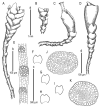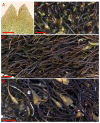Stolonicaulon: A Section-Puzzle within Marsupella (Gymnomitriaceae, Marchantiophyta)
- PMID: 35736747
- PMCID: PMC9230718
- DOI: 10.3390/plants11121596
Stolonicaulon: A Section-Puzzle within Marsupella (Gymnomitriaceae, Marchantiophyta)
Abstract
Marsupella sect. Stolonicaulon is not speciose and is a commonly neglected section within the genus, which currently includes three species with somewhat similar morphologies (wiry shoots with distanced leaves) and distributions in the mountains of tropical and subtropical regions (SE (Southeast) Asia, the Venezuelan Andes, and the high mountains of SE Brazil). After studying materials that were found to be dissimilar to the "traditional" Marsupella that were collected in the last decade by the authors of this article, it was found that these plants belong to three new-for-science species, and all of these species should be included in Marsupella sect. Stolonicaulon. The newly described species have expanded the boundaries of morphological variability, not only for the section itself, but also for the genus based on two findings: (1) the leaves of Marsupella sect. Stolonicaulon can be either appressed and entire or spaced and deeply divided (thus, the plants could occasionally be similar to Cephaloziella or Anastrophyllum); (2) some species of the section possess regular underleaf production. The first discovery of regular underleaves in Marsupella, as noted in two of the three newly described taxa, is the main morphological novelty described in this paper. The development of regular underleaves is a presumable relict character that brings Marsupella closer to Nardia, which was recently transferred to the Gymnomitriaceae and occupies an isolated position within its own subfamily, Nardioideae.
Keywords: Gymnomitriaceae; Marchantiophyta; Marsupella; Pacific Asia; molecular phylogenetic; phytogeography.
Conflict of interest statement
The authors declare no conflict of interest.
Figures











References
-
- Kitagawa N. Marsupellae of Mt. Kinabalu, North Borneo. J. Hattori Bot. Lab. 1967;30:199–204.
-
- Schuster R.M. Studies on antipodal hepaticae. XII. Gymnomitriaceae. J. Hattori Bot. Lab. 1996;80:1–147.
-
- Vilnet A.A., Konstantinova N.A., Troitsky A.V. Molecular insight on phylogeny and systematics of the Lophoziaceae, Scapaniaceae, Gymnomitriaceae and Jungermanniaceae. Arctoa. 2010;19:31–50. doi: 10.15298/arctoa.19.02. - DOI
-
- Shaw B., Crandall-Stotler B., Váňa J., Stotler R.E., von Konrat M., Engel J.J., Davis E.C., Long D.G., Sova P., Shaw A.J. Phylogenetic relationships and morphological evolution in a major clade of leafy liverworts (phylum Marchantiophyta, order Jungermanniales): Suborder Jungermanniineae. Syst. Bot. 2015;40:27–45. doi: 10.1600/036364415X686314. - DOI
-
- Vana J., Söderström L., Hagborg A., Von Konrat M. Notes on Early Land Plants Today. 60. Circumscription of Gymnomitriaceae (Marchantiophyta) Phytotaxa. 2014;183:287–289. doi: 10.11646/phytotaxa.183.4.9. - DOI
Grants and funding
LinkOut - more resources
Full Text Sources

